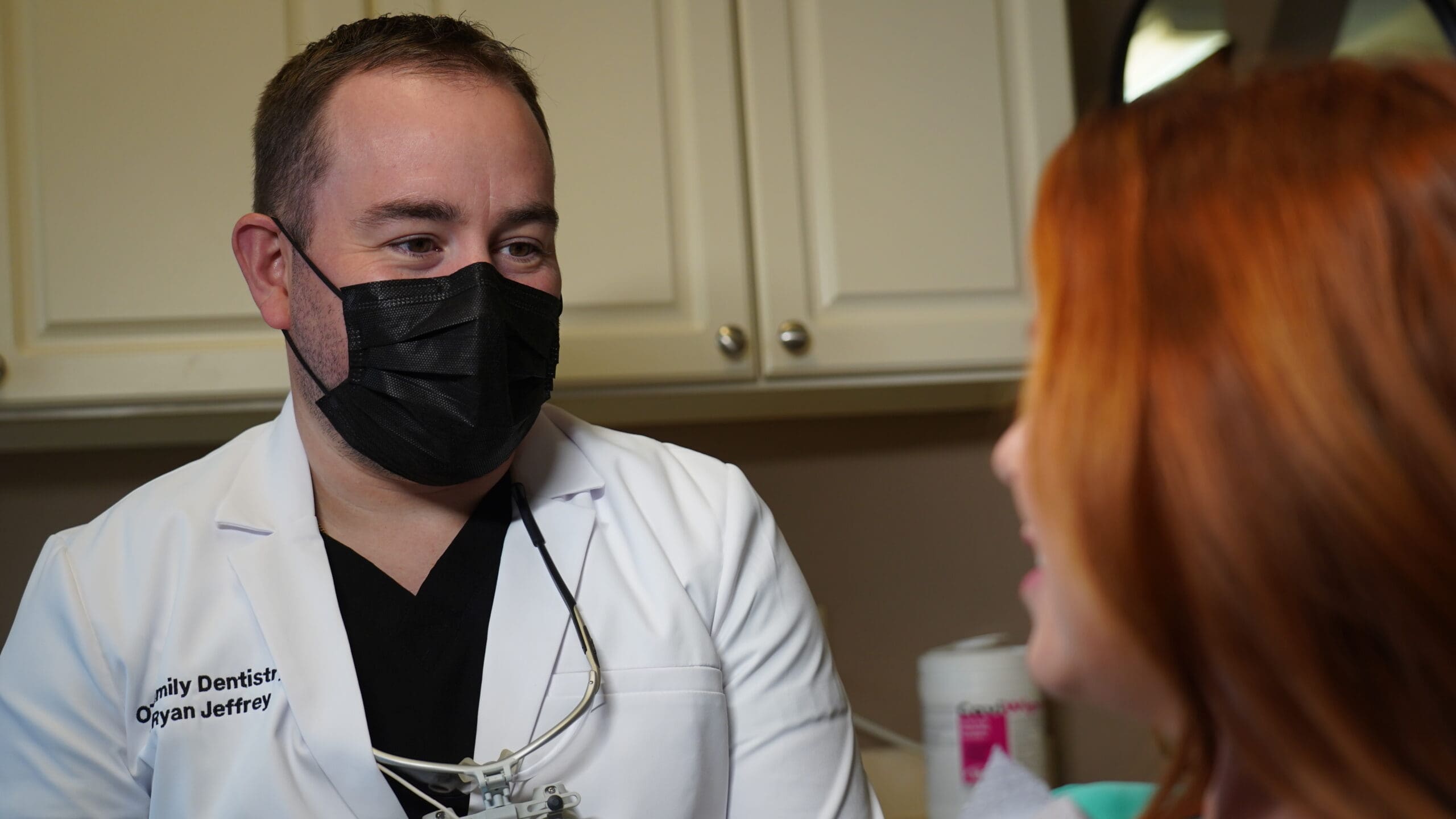FAQs

FREQUENTLY ASKED QUESTIONS
No, we no longer accept MaineCare as a form of payment.
No, we are not, we only participate with Delta Dental, however, we do bill most insurances and ask for payment of copay or deductible at the time of service.
Yes, Dr. Jeffrey performs Root Canals.
- Gingivitis is gingival inflammation caused typically by bacteria sitting around the tooth. Gingivitis is reversible by good oral hygiene habits and does not cause bone loss to the tooth.
- Periodontitis is when bad types of bacteria reside in the pocketing around the tooth that releases toxins which can cause bone loss to the tooth. Untreated periodontitis can ultimately cause tooth loss. Regular visits to the dentist for cleanings can prevent the onset of periodontal disease.
X-rays are important to take to help diagnose any problems that may be developing with your teeth and surrounding structures that support your teeth. Bitewing X-rays are taken yearly to detect any cavities that may be forming. A Panorex X-ray is taken every 3-5 years to check the areas beneath the crowns of your teeth. These areas sometimes develop infections that we can detect prior to you having symptoms.
Each patient is different. Some patients build up plaque and tartar at a faster rate than others. Some patients have better home care habits. Bottom line, your dentist and/or dental hygienist can assist you in recommending how frequent you should return to the office for routine care.
We recommend that once the child has their first tooth, they should start getting familiar with the dental office. You can find more information about child dentistry on our child dentistry page.
Dental exams give us the opportunity to evaluate your current methods of dental care and provide suggestions for future care in order to protect you from complications such as cavities and gum disease. They also allow us to detect problems early so they can be fixed quickly and easily.
Dental exams should generally take place every six months. However, consult with our team to decide how often you should be examined, for we may suggest that you visit more frequently based on factors such as smoking, frequency of cavities and genetic susceptibility to tooth and root decay as well as gum disease.
At a typical dental exam, our team will thoroughly clean your teeth, removing any surface stains or deposits, called tartar or calculus, that are more difficult to remove than plaque and require the assistance of professional dental instruments. We will also check for signs of decay or gum disease. An X-ray may be performed to provide a more detailed summary of your oral health and to more closely identify any problems. We will ask you questions about your current methods of dental care, such as how often you brush your teeth, and floss, as well as whether you use a toothpaste with fluoride. With this information in mind, we will demonstrate proper dental care and provide suggestions on how to improve your habits to promote optimal oral health.
The best way to prepare for a dental exam is to practice good dental care. Brushing your teeth twice a day and flossing at least once a day is recommended. Be sure to clean your teeth before you arrive at your appointment. Our team will be cleaning your teeth for you, but it is helpful to remove food and plaque beforehand so we can focus on the more difficult-to-clean areas. You also want to make sure you are prepared to share pertinent information such as your medical history, insurance coverage and current dental care methods with us. Don’t be embarrassed to be honest about your oral health habits – our team is not here to judge you, but to work with you to improve your habits and ensure dental health! Lastly, be prepared to schedule a follow-up appointment or future check-up at the end of your dental exam.
Adults over 35 years old lose more teeth to gum diseases (periodontal disease) than from cavities. Three out of four adults are affected at some time in their life. The best way to prevent cavities and periodontal disease is by good tooth brushing and flossing techniques, performed daily.
Periodontal disease and decay are both caused by bacterial plaque. Plaque is a colorless film, which sticks to your teeth at the gum line. Plaque constantly forms on your teeth. By thorough daily brushing and flossing you can remove these germs and help prevent periodontal disease.
Dr. Jeffrey recommends using a soft to medium toothbrush. Position the brush at a 45-degree angle where your gums and teeth meet. Gently move the brush in a circular motion several times using small, gentle strokes brushing the outside surfaces of your teeth. Use light pressure while putting the bristles between the teeth, but not so much pressure that you feel any discomfort.
When you are done cleaning the outside surfaces of all your teeth, follow the same directions while cleaning the inside of the back teeth.
To clean the inside surfaces of the upper and lower front teeth, hold the brush vertically. Make several gentle back-and-forth strokes over each tooth. Don’t forget to gently brush the surrounding gum tissue.
Next, you will clean the biting surfaces of your teeth by using short, gentle strokes. Change the position of the brush as often as necessary to reach and clean all surfaces. Try to watch yourself in the mirror to make sure you clean each surface. After you are done, rinse vigorously to remove any plaque you might have loosened while brushing.
Periodontal disease usually appears between the teeth where your toothbrush cannot reach. Flossing is a very effective way to remove plaque from those surfaces. However, it is important to develop the proper technique. The following instructions will help you, but remember it takes time and practice.
Start with a piece of floss (waxed is easier) about 18” long. Lightly wrap most of the floss around the middle finger of one hand. Wrap the rest of the floss around the middle finger of the other hand.
To clean the upper teeth, hold the floss tightly between the thumb and forefinger of each hand. Gently insert the floss tightly between the teeth using a back-and-forth motion. Do not force the floss or try to snap it into place. Bring the floss to the gum line then curve it into a C-shape against one tooth. Slide it into the space between the gum and the tooth until you feel light resistance. Move the floss up and down on the side of one tooth. Remember there are two tooth surfaces that need to be cleaned in each space. Continue to floss each side of all the upper teeth. Be careful not to cut the gum tissue between the teeth. As the floss becomes soiled, turn from one finger to the other to get a fresh section.
To clean between the bottom teeth, guide the floss using the forefingers of both hands. Do not forget the backside of the last tooth on both sides, upper and lower.
When you are done, rinse vigorously with water to remove plaque and food particles. Do not be alarmed if during the first week of flossing your gums bleed or are a little sore. If your gums hurt while flossing you could be doing it too hard or pinching the gum. As you floss daily and remove the plaque your gums will heal and the bleeding should stop.
Sometimes after dental treatment, teeth are sensitive to hot and cold. This should not last long, but only if the mouth is kept clean. If the mouth is not kept clean the sensitivity will remain and could become more severe. If your teeth are especially sensitive consult with your doctor. They may recommend a medicated toothpaste or mouth rinse made especially for sensitive teeth.
There are so many products on the market it can become confusing and choosing between all the products can be difficult. Here are some suggestions for choosing dental care products that will work for most patients.
Automatic and “high-tech” electronic toothbrushes are safe and effective for the majority of the patients. Oral irrigators (water spraying devices) will rinse your mouth thoroughly, but will not remove plaque. You need to brush and floss in conjunction with the irrigator. We see excellent results with electric toothbrushes called Rotadent and Interplak.
Some toothbrushes have a rubber tip on the handle, this is used to massage the gums after brushing. There are also tiny brushes (interproximal toothbrushes) that clean between your teeth. If these are used improperly you could injure the gums, so discuss proper use with your doctor.
Fluoride toothpaste and mouth rinses, if used in conjunction with brushing and flossing, can reduce tooth decay as much as 40%. Remember, these rinses are not recommended for children under six years of age. Tartar control toothpaste will reduce tartar above the gum line, but gum disease starts below the gum line so these products have not been proven to reduce the early stage of gum disease.
Anti-plaque rinses, approved by the American Dental Association, contain agents that may help bring early gum disease under control. Use these in conjunction with brushing and flossing.
Daily brushing and flossing will keep dental calculus to a minimum, but a professional dental cleaning will remove calculus in places your toothbrush and floss have missed. Your visit to our office is an important part of your program to prevent gum disease. Keep your teeth for your lifetime.
